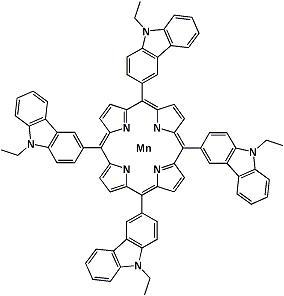Manganese 5,10,15,20-Tetra(N-ethyl-3-carbazolyl) Porphyrin
Abstract
:Introduction

Experimental Section
Chemicals and Reagents
Instrumentation
Synthesis
Results and Discussion
Conclusion
Supplementary materials
Supplementary File 1Supplementary File 2Supplementary File 3Acknowledgements
References and Notes
- Tidwell, C.P.; Alexander, L.A.; Fondren, L.D.; Belmore, K.; Nikles, D.E. Synthesis and characterization of 5,10,15,20-tetra(N-ethyl-3-carbazoyl) porphyrin. Indian J. Chem. Sect. B 2007, 46B, 1658–1665. [Google Scholar]
- Kelly, S.L.; Kadish, K.M. Counterion and solvent effects on the electrode reactions of manganese porphyrins. Inorg. Chem. 1982, 21, 3631–3639. [Google Scholar] [CrossRef]
- Boucher, L.J.; Garber, H.K. Manganese porphyrin complexes. IV. Reduction of manganese porphyrins. Inorg. Chem. 1970, 9, 2644–2649. [Google Scholar] [CrossRef]
© 2010 by the authors; licensee Molecular Diversity Preservation International, Basel, Switzerland. This article is an open-access article distributed under the terms and conditions of the Creative Commons Attribution license (http://creativecommons.org/licenses/by/3.0/).
Share and Cite
Pruitt Tidwell, C.; Fondren, L.D.; Nikles, D.E. Manganese 5,10,15,20-Tetra(N-ethyl-3-carbazolyl) Porphyrin. Molbank 2010, 2010, M656. https://doi.org/10.3390/M656
Pruitt Tidwell C, Fondren LD, Nikles DE. Manganese 5,10,15,20-Tetra(N-ethyl-3-carbazolyl) Porphyrin. Molbank. 2010; 2010(1):M656. https://doi.org/10.3390/M656
Chicago/Turabian StylePruitt Tidwell, Cynthia, L. Dalila Fondren, and David E. Nikles. 2010. "Manganese 5,10,15,20-Tetra(N-ethyl-3-carbazolyl) Porphyrin" Molbank 2010, no. 1: M656. https://doi.org/10.3390/M656




